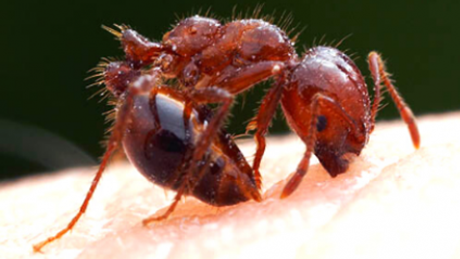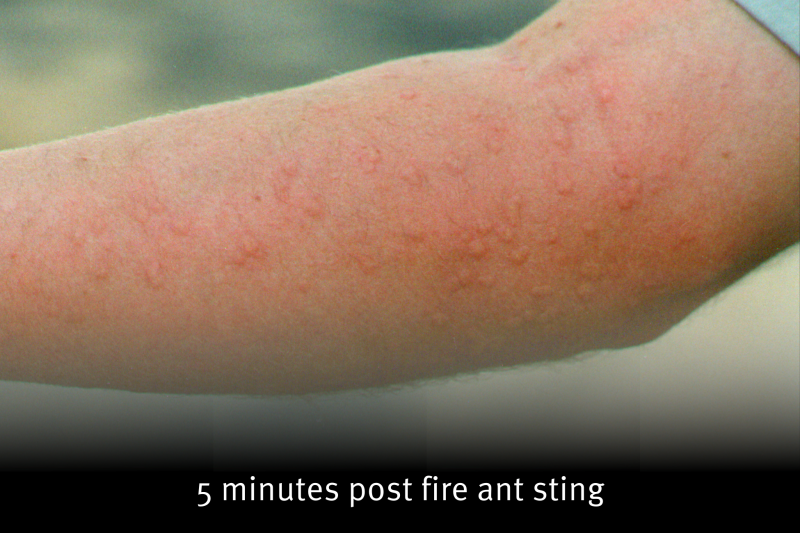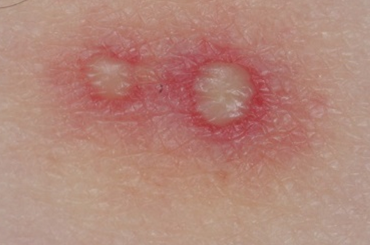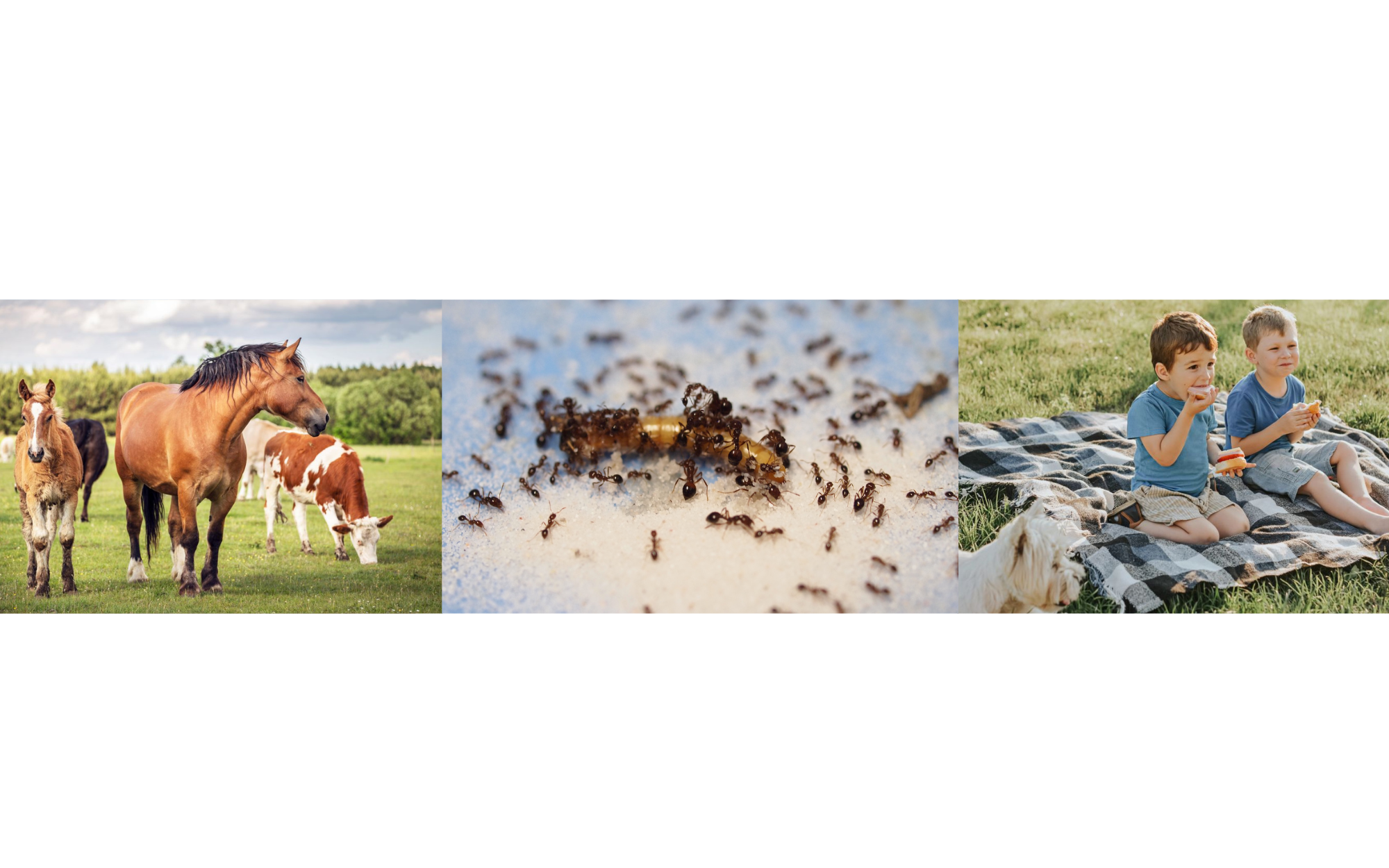Call 000 if someone experiences severe symptoms
Fire ant stings are rarely life-threatening. However, people who are prone to allergic reactions could experience severe symptoms and should seek immediate medical attention.
Call 000 if you or someone around you experiences the rapid onset of flushing, general hives, swelling of the face, eyes or throat, chest pains, nausea, severe sweating, breathing difficulties or faintness.
If you're stung:
- seek medical attention if you a prone to allergic reactions or experience symptoms of anaphylaxis
- apply a cold compress or ice to the stings to relieve the swelling and pain
- small blisters may form on your skin
- leave the blisters intact and wash gently with soap and water.
The above guidance is general information and if in doubt, seek medical advice. See advice for medical practitioners below.
Human impacts
Fire ants are aggressive, and have a severe, burning sting that is extremely painful. Humans are at risk of tens or hundreds of stings within seconds from swarming fire ants, if a nest is disturbed.
Each ant delivers many stings causing the sensation that the body is on fire, and the painful burning sensation can last up to an hour. Small white pustules form within 48 hours of being stung which can become itchy and infected.
Domestic animals
Any animals that spend time outdoors are at risk of fire ant stings, particularly if they graze or like to dig. Fire ants tend to swarm the faces of pets and grazing animals, targeting the nose, mouth and ears. Stings can cause swelling, preventing animals from eating, drinking or breathing. Fire ants can easily overwhelm animals much bigger than themselves.
Natural environment
Fire ants feed on ground dwelling/nesting insects, spiders, lizards, frogs, birds, and mammals. They can displace or kill off Australian plants and animals and change environments beyond repair. They have no natural predators in Australia.
It is estimated fire ants may reduce biodiversity in up to 45% of birds, 38% of mammals, 69% of reptiles and 95% of frogs. (Source)
The 'Great Outdoors'
Fire ant infestation restricts everyday activities such as picnics and outdoor play, and sporting activities. Backyards, parks, playgrounds, beaches and sports grounds become unusable. For example, in areas of Texas where fire ants are established, it is not possible to have a picnic or play outside due to fire ants presence. Areas infested have less social value and may not be cared for.
Equipment and infrastructure
Fire ants can also cause damage to sensitive electrical equipment like meter boxes, traffic lights and air conditioners by chewing through the insulation, causing malfunction and increase maintenance costs.
Agriculture
Many agricultural and horticultural crops can be affected by fire ants increasing the cost of production and supply of goods and services. Fire ant nests can also damage equipment such as irrigation systems and machinery.
Livestock can be stung by fire ants. Stinging around the eyes, mouth, and nose can cause suffocation and blindness. They can also prevent animals from reaching food and water leading to starvation and dehydration.
Fire ant presence limits the ability to export goods to states or countries free of them.
Information for medical practitioners
The presence of fire ants in NSW is notifiable under the NSW Biosecurity Act 2015. Medical practitioners have a duty to notify the NSW Department of Primary Industries if they suspect or confirm a patient has been stung by fire ants in NSW.
Fire ants are a small 2 to 6 mm invasive ant from South America that cause extreme economic, environmental, and social impacts.
Fire ant stinging attacks are most likely to occur in northern NSW, close to the border with Southeast Queensland, but could occur elsewhere in NSW.
If ants are present on a victim, collect a specimen for identification.
Wear latex gloves to prevent stings. Using a tissue, collect the ants and put them in a jar which can be sealed and place in the freezer.
Useful information
Characteristics of fire ant attack
- Fire ants are aggressive and will swarm and attack people and animals if disturbed.
- Tens to hundreds of ants can swarm onto a person within a few seconds and sting simultaneously, injecting venom that causes a painful local reaction.
- Each ant can deliver multiple stings. It’s possible, but unlikely a victim would be stung only once or twice.

Characteristics of fire ant stings
- Stings may initially appear as raised welts or hive-like lesions associated with intense burning, itchiness and redness.
- Small pustules or blisters usually develop at the sting site after a couple of hours or up to two days later. These may be itchy and take up to 10 days to heal.
- Some people may develop severe swelling at the sting site.
Image: Fire ant stings after five minutes. Credit: Alex Wyld/QLD DAF

Systemic allergic reactions
- Severe allergic reactions and anaphylaxis can occur following fire ant stings.
- Severe reactions and anaphylaxis may be more common in people previously stung by fire ants or who have a history of allergic reactions to insects.
Image: Fire ant stings after 48 hours. Credit: Alex Wyld/QLD DAF

Treating fire ant stings
- use simple analgesia and cold compress or ice to relieve swelling and pain
- wash affected area with soap and cool water, advise patients to keep sting site clean
- keep the blisters intact to prevent infection. Advise patients to avoid scratching
- consider antihistamines to manage minor localised reactions and itching
- topical or oral steroids can be considered for large, localised reactions
- manage anaphylaxis immediately with adrenaline, as per standard protocols
- call 000 and refer to an Emergency Department if severe symptoms appear
- call the Poisons Information Centre 131 126 for clinical advice.

